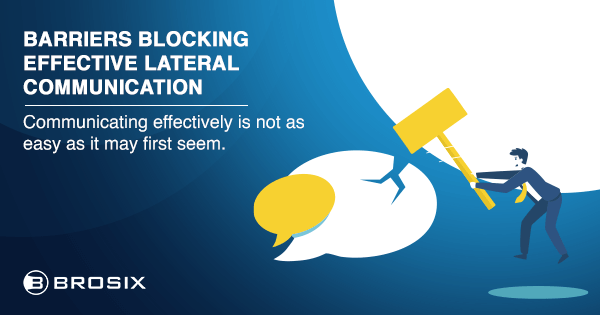With technology evolving at tremendous speed, new business opportunities emerge daily. This implies the creation of new jobs, roles, and, ultimately, the development of new skills.
Having multiple domain-related skills has proven to boost careers, making professionals highly desirable. Nevertheless, when making hiring decisions, many companies would instead focus more on a candidate’s soft skills, as it turns out.
As an example, did you know that good communication is among the top three skills employers look for?
While downward or even upward communication are commonplace in many organizations, one other key ingredient needs to be included for truly effective internal communication – lateral communication.
What is lateral communication?
Lateral communication is the sharing of information, ideas, feelings, or concerns between peers within an organization or same-level coworkers regarding their tasks.
Looking at the modern business environment, we can see that small businesses and start-ups are major players in the economy. Usually consisting of a small team and a flat organizational structure, these companies are some of the most successful in their industry.
They are also a prime example of lateral communication, mainly since working in small teams requires less time spent on back-and-forth feedback and more time dedicated to making things happen.
However, even if these organizations were among the first to highlight the importance of lateral communication in the workplace, this doesn’t mean it’s only applicable or important for this type of company.
Advantages of lateral communication in an organization
Good communication processes – either internal or external, are a determining factor of any company’s success.
To ensure productivity and growth, every level of the internal communication process should be a well-oiled machine.
While inspiring collaboration across teams and departments is one of the many advantages of lateral communication, it’s worth mentioning a couple more.
- Lateral communication at work makes employees more time-efficient
Since lateral communication consists of conversations between peers, it is usually more informal, easier to engage in, and less stressful. Which leads to more direct and perhaps more productive dialogues.
To highlight this idea, let’s look at an example. Let’s assume an employee has to complete a task they’ve never done before, while some of their co-workers have experience in the area.
Instead of wasting time searching on Google, which could be fruitless or time-consuming, why not ask around? The colleagues who have actual experience in completing the given task may be of great help. This way, information could be delivered faster, tailored to the seeker’s need, and maybe even accompanied by practical examples.
- Efficient lateral communication leads to increased work productivity
Besides increasing trust and empathy between co-workers, effective lateral communication can bring quick and precise clarification to ongoing projects. If there’s a team working on an assignment, the team should make sure they are in sync with their work. This will prevent potential delays, errors or malfunctions.
On another note, lateral communication inspires ideas and projects that can put an organization on the map for international recognition or increase its popularity. Furthermore, incredible ideas can be born out of effective lateral communication in a brainstorming session!
Equally, lateral communication – or horizontal communication, as some people call it, leads to smoother problem-solving and conflict resolution.
Barriers blocking effective lateral communication
Communicating – or to clarify – communicating effectively is not as easy as it may first seem. That’s because people have different personalities and communication styles.
There are usually multiple roles within a team, with some being more challenging, satisfying, or desirable than others. As a result, potential competitiveness or rivalry between co-workers may arise.
All of this manifests as barriers to horizontal communication.
To showcase the importance of lateral communication and collaboration among co-workers, here are a couple of communication quotes highlighting some successful professional’s opinions:
- Irene McConnell, Managing Director at Arielle Execute
“Professional environments are all about networking and communication. The importance of expressing yourself cannot be undermined under any circumstances. Open communication in a professional setting allows you to stamp your opinion on work-related matters and gives more room for value among the team.”
- Christian Velitchkov, Co-Founder of Twiz LLC
“Working collaboratively gives employees a sense of belonging to an organization while improving productivity. In addition, it becomes easier to brainstorm ideas to solve a problem or complete a project on time.”
- Braden Norwood, Content & SEO Specialist at VTR Learning
“Though it might go without saying, communication is a team exercise, and as long as only one party invests themselves, clarity will suffer. So, each side must learn eloquence or fluency and understand how to listen.”
How to improve lateral communication at work?
To master lateral communication and have productive exchanges with co-workers, employees must see their colleagues as team members. This means not just as people who we happen to work next to, but as reliable, valuable, and enjoyable team members.
Fostering this kind of organizational culture is not accomplished only through shared projects and meetings. Team-building activities are, in fact, the most successful means of creating a cohesive team.
As for more formal, strictly work-related interactions, employees need to be equipped with the right tools – from group chats to video calling apps, so that workplace communication can run as smoothly as possible. Especially in the case of remote working.
Wrap up
Now that you have all the information you need to improve lateral communication in your company, it’s time to start testing and discover which techniques work best for you!
Additionally, Brosix is a tool that can help you!
Since it offers a variety of features, it can be your all-in-one tool, helping you enhance your team’s communication and increase productivity!
FAQ
How does lateral communication differ from vertical communication?
Lateral communication involves communication across the same hierarchical level within the organization, while vertical communication occurs between different hierarchical levels (such as between employees and managers).
What are the challenges of lateral communication?
Lateral communication may face challenges, such as:
- lack of trust and openness among employees
- miscommunication
- competition between departments
- misinterpretation of messages
- lack of clear communication channels and tools
- different communication practices across teams
- information overload
- poor listening skills
- language or cultural barriers
In addition, hierarchy and power dynamics can hinder the flow of communication. It is important to address these challenges by promoting effective communication practices, providing training and resources, and fostering a culture of open and transparent communication.
How can organizations encourage and facilitate lateral communication?
Organizations can encourage and facilitate lateral communication by creating a culture of openness, trust, and collaboration. They can promote teamwork and cross-departmental projects, provide opportunities for informal interactions and knowledge sharing, and establish communication platforms and channels that facilitate the exchange of information and ideas. It is also important to lead by example and recognize and reward effective communication.
How does the quality of lateral communication affect overall organizational communication?
The quality of lateral communication has a significant impact on overall organizational communication. Effective peer communication promotes a positive and cohesive company culture, enhances team collaboration, and improves the exchange of information and ideas. It contributes to a more efficient and productive work environment and can positively influence the overall quality and flow of communication.
How can businesses measure and evaluate the effectiveness of lateral communication?
Businesses can measure and evaluate the effectiveness of lateral communication by conducting surveys or feedback sessions to assess employee perceptions and satisfaction. They can analyze the frequency and quality of information exchange, collaboration, and problem-solving activities. Additionally, organizations can track the impact of horizontal communication on team performance, project outcomes, and overall employee engagement and productivity.










